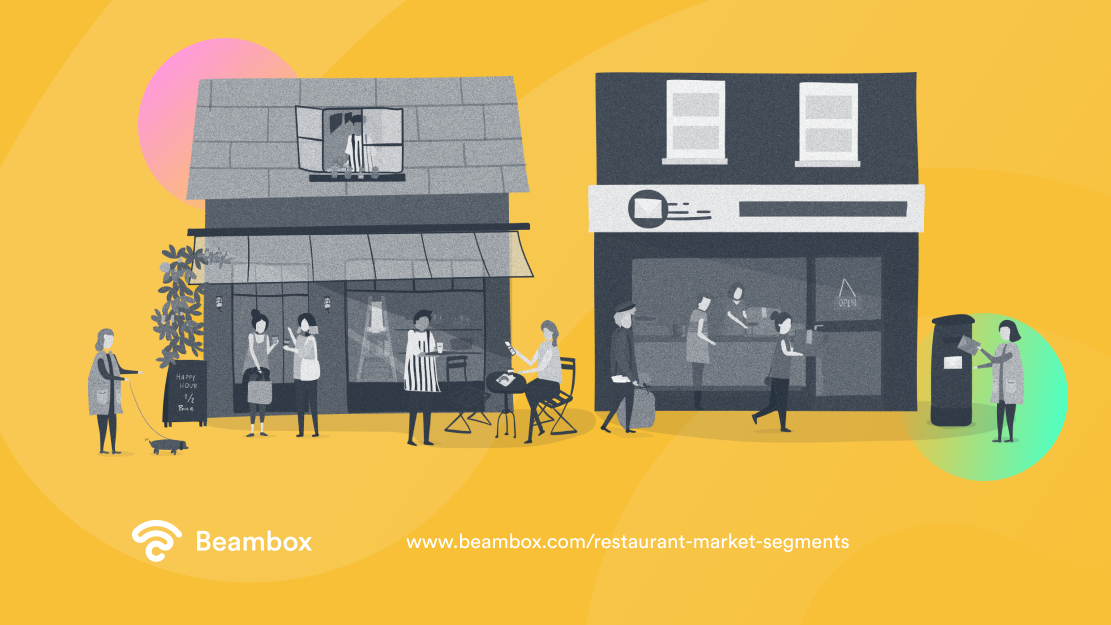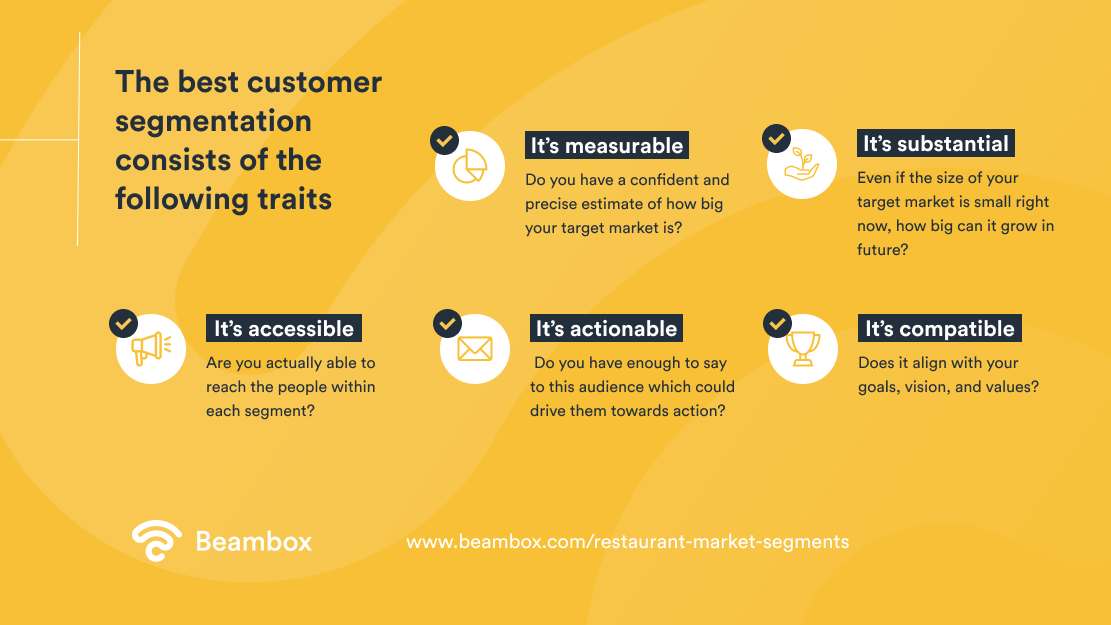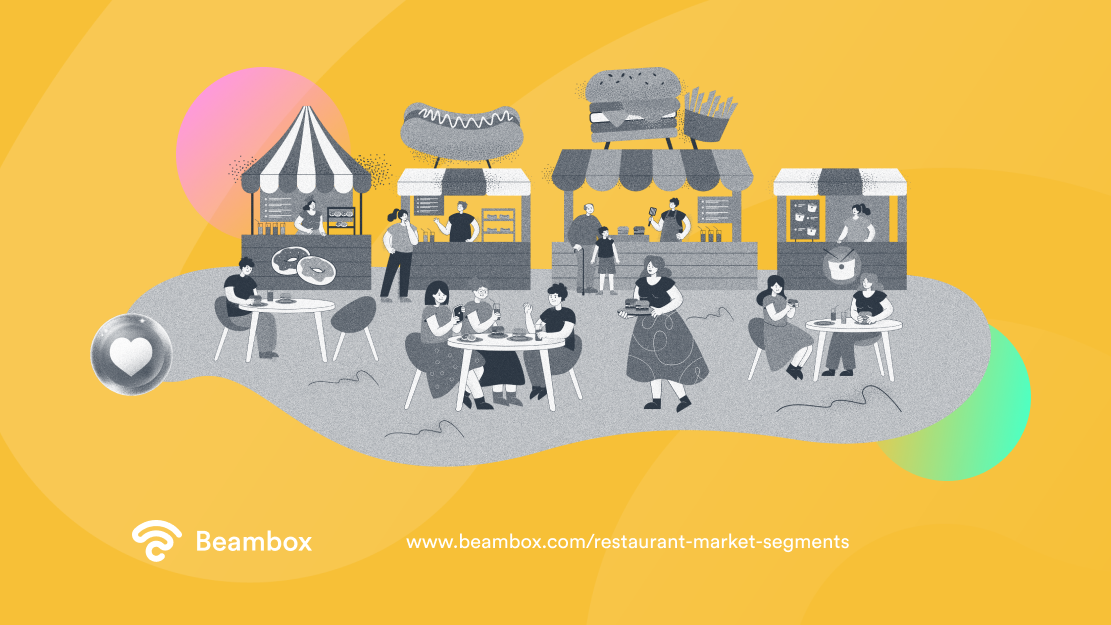Restaurant Market Segments: Different Customers, Different Needs
Every customer is a valued customer. Each one expects and deserves quality service and hospitality. In the restaurant business, however, understanding restaurant market segments — properly identifying customer groups based on behaviors, needs, etc. — can help you unlock even greater business potential. With proper customer segmentation and suitably targeted offerings, you’ll experience a much more predictable flow of customers and you’ll be better equipped to meet their unique needs.
Indeed, some studies have found that email campaigns sent to segmented audiences have 14% higher open rates. Here is your ultimate guide to restaurant market segmentation.

What Is Market Segmentation for a Restaurant?
Market segmentation for a restaurant is simply the process of dividing your entire customer base into smaller groups based on similar demographics or traits.
Consider a country’s Olympic team. There isn’t a country on the planet that would throw its entire team into the 400m relay, because only a small subset of them will actually be any good at it.
Instead, the team is segmented into groups, or categorized according to their talents. You need to do the same thing with your restaurant’s customer base if you want to achieve optimized marketing communication — or messaging that hits the right spot at the right time and via the most appropriate channel.

Why Restaurant Market Segmentation Comes Before Targeting and Positioning
Let’s consider one of the most strategic methods for conducting any marketing campaign, which has established that restaurant market segmentation must come before targeting and positioning:

Targeting a customer base is something every ambitious business owner does, and this is typically carried out via a number of channels such as booking engines, social media, and email.
Positioning is all about deciding what type of message you’ll use to communicate whatever it is you want to say.
The only problem is you can’t do either of those things effectively without first segmenting your audience. Without proper customer segmentation, you’ll end up sending the same message to every single person, regardless of their demographic, preferences, consumer behaviors, etc.
How many of those people will actually be interested in a one-for-all message?
Key Aspects of Customer Segmentation Done Right
The best customer segmentation consists of the following traits:
- It’s measurable. Do you have a confident and precise estimate of how big your target market is?
- It’s substantial. Even if the size of your target market is small right now, how big can it grow in future?
- It’s accessible. Are you actually able to reach the people within each segment?
- It’s actionable. Do you have enough to say to this audience which could drive them towards action?
- It’s compatible. Does it align with your goals, vision, and values?
When you do restaurant market segmentation correctly, you can experience as much as a 760% increase in revenue. A properly segmented customer base will also help you create far more successful menus.

The 4 Types of Market Segmentation for Restaurants
The good news is that, just like so many things in marketing, market segmentation for a restaurant is pretty straightforward.
In fact, there are just four types of market segmentation to focus on, and all of them are absolutely relevant to the hospitality industry.
1. Restaurant Market Segments Using Demographics
This restaurant market segment is all about who your customers are, and it’s probably the most common type of market segmentation.
Your customer demographics include the following non-identifiable traits:
- Age
- Gender
- Income
- Ethnicity
- Religion
- Education
- Occupation
These traits can be combined any number of ways, as well. For instance, you may decide to target a specific offer at people who fall within a particular income bracket, age group, and occupation.
2. Restaurant Market Segments Based on Psychographics
This restaurant market segmentation approach focuses on the whys behind your customers’ behaviors, based on their interests and personalities. Psychographic segmentation gives you the opportunity to define your customer groups by their:
- Hobbies
- Personality
- Values
- Lifestyle
- Beliefs
You can go much further, though, and this is where thorough research into your customer base is so important. The more you know about what makes them tick, the more you can expand the list above and create incredibly valuable customer segments.
3. Restaurant Market Segments Based on Psychographics
This restaurant market segment is all about location, location, location. It’s arguably one of the most important market segmentation techniques for hospitality venues (like restaurants, cafes, and hotels) because identifying customer groups based on where they live will give you a very good idea of how likely they are to visit you.
The most common data for geographic segmentation include:
- Country
- State
- County
- City
- Postal code
When you have your customers’ geographic data, you can far more accurately target customers on your doorstep and create separate campaigns to tempt those farther afield.
4. Restaurant Market Segments Based on Behaviors
This is where restaurant market segmentation gets really exciting.
Behavioral segmentation is all about the how, i.e., how you can influence a desirable change in your customers’ behaviors or encourage them to repeat favorable behaviors by understanding their past habits when engaging with your venue.
For instance, you might be able to find out their spending habits, favorite dishes, frequency of visits, and their degree of loyalty. This kind of information is gold and it’s why behavioral marketing is becoming more mainstream than ever before.

Hospitality Market Segmentation Best Practices
After diving into the nuts and bolts of market segmentation for restaurants, how do we ensure it helps you achieve your most important business goals? The following best practices for restaurant market segmentation will help you divide your customer lists effectively and design your marketing campaigns around each segment.
-
Know your customers - Where do they come from? What do they love? What don’t they like? What do they yearn for? You need to know your customers like you do your best friends.
-
Always set goals - Every customer segment you create needs a solid goal behind it. For instance, do you want to get more bookings from that particular segment, or use it to expand your brand into another territory?
-
Don’t get mega specific - Segmentation works best when it’s high level. You should be able to explain each segment in no more than three adjectives, i.e., if you have to say “customers who dine with us on Tuesdays, after 8pm and who are between the age of 23 and 31” the segment is way too specific. A customer segment has to be big enough to make a significant impact on your business.
-
Test, test, test - You won’t get this right the first time. Every time you create a new market segment, you need to test it with various types of messaging and through different forms of communication to see if you’ve correctly identified a common group of people.
-
Go back to your segments - Market segments evolve over time; the people within them change, just as your business and the market itself also evolve. This is why you need to revisit your segments to see if you need to adapt them to address any changes that have taken place within the target market.
Market Segmentation Examples for Restaurants
Before we sign off, here are some market segmentation examples for restaurants to get you started. We’ve picked four which we think were the most relevant in 2021.
-
Price This is as simple as it gets. Restaurants should build menus and offers around customer segments based on the price they’re willing to pay or how much they can afford. For instance, office workers probably have a smaller budget for lunch compared to a family of four, so the marketing messages you send each group should take this difference into account.
-
Customer type You probably have far more types of customers than you think. So sit down and do a careful analysis of all of the people who have visited you. Look beyond leisure and business. Think about the generation in which they belong; what lifestyles they lead; and the competing restaurants they’re likely to visit when they’re not at yours.
-
Service The type of service you offer can - and should - be greatly influenced by your restaurant market segments. For instance, if you have a large number of young, affluent people visiting regularly, they’ll require a different service compared to that which you provide to a smaller number of retirees who pop in occasionally. It’s just as important to be able to identify when these two segments are likely to make an appearance so you can fine-tune your service as necessary.
-
Product One menu for all? Nah. You should offer the appropriate products to the right customers. If we go back to the restaurant price example, those office workers are probably going to want something fast but satisfying, while the family of four will be far more interested in multiple courses and hearty stomach-fillers.

Fast Food Market Segmentation
Let us take a look at a specific example of fast food market segmentation to conclude our guide on restaurant market segments. Fast food remains a popular choice for the eat-out-of-home market despite the fact that it’s not the healthiest option. One study on market segmentation for fast food looked at the “needs and motivations” of various fast food consumers and created customer segments based on the benefits they look for when they choose to eat fast food. The study identified six market segments, namely:
- Family treat. This market segment considers fast food as a reward or treat for the family.
- I like it. This market segment chooses fast food primarily because they enjoy it.
- Nice and easy. This fast food market segment desires convenience over other factors.
- Pressed for time. This segment chooses fast food out of necessity or, more specifically, because it’s fast.
- Real meal. This segment likes the convenience of fast food but also has a preference for healthy food options.
- Meeting place. This customer segment chooses fast food because it’s there, or because it’s a great venue for social meetups or business meetings.
The above restaurant market segments is a good example of how the different types of market segmentation approaches are used to correctly identify different customer groups. It should also give you an idea of how you can design an effective marketing strategy for each segment.

Using WiFi Marketing to Identify Customer Segments
For many people, the dining experience is not complete without the “ceremonial” food photography before everyone digs in. And the sooner diners are able to post their food pics on social media, the better — both for them and for your business. With a fast and reliable guest WiFi, you will not just be meeting the connectivity needs of your guests; you will also encourage the aforementioned and highly favorable dining ritual — which is free promotion for your business!
With the right WiFi setup, you can have an opportunity that will also allow you to accurately identify market segments for your restaurant. A fully customizable WiFi system, like Beambox, is a sophisticated WiFi marketing platform that enhances the guest WiFi experience and gives you access to a variety of tools to help you boost business, build customer loyalty, and manage your online reputation by learning more about your various customer segments.
You can have end-to-end control of the guest WiFi experience to make it work to your advantage. Build your restaurant email list or SMS subscriber list via a customized captive portal. You can also limit WiFi access, automatically prompt guests to leave an online review, or drive them to your social media pages.
Beambox is an all-in-one WiFi solution that accomplishes all of the above and more. We have an existing client base of over 3,000 venues, and our customizable WiFi marketing solutions have been used in impressive and rewarding ways. You can drive sales with time-sensitive deals and promos for your restaurant, boost social engagement through Instagram or Facebook contests, and climb up on online ranking platforms through real-time customer reviews. Accelerate your business growth — start your Beambox free trial today!
Get Started With Free WiFi Marketing
Beambox helps businesses like yours grow with data capture, marketing automation and reputation management.
Sign up for 30 days free


